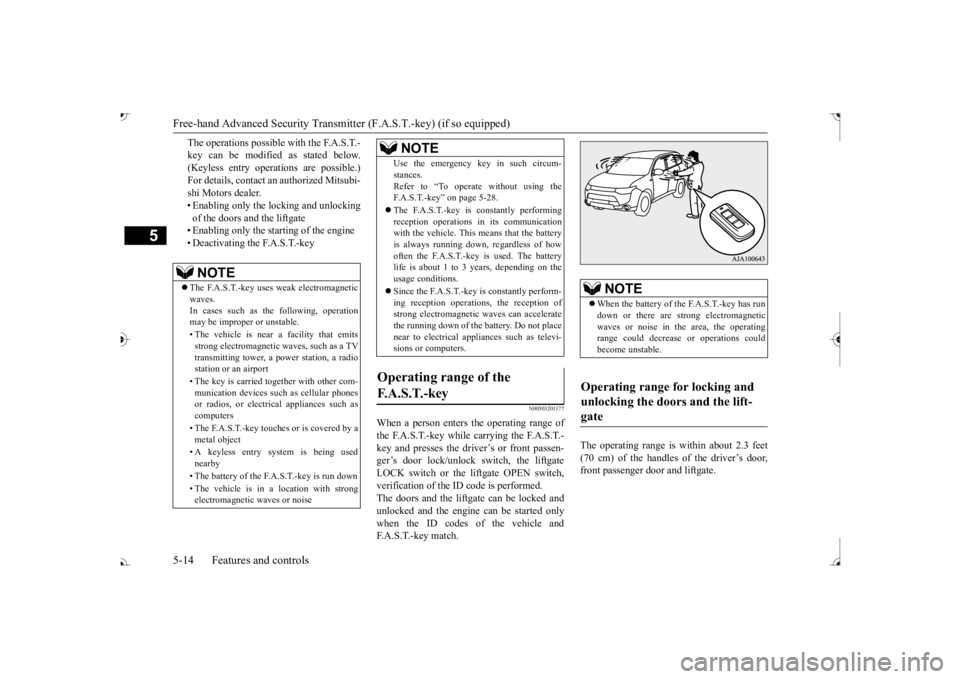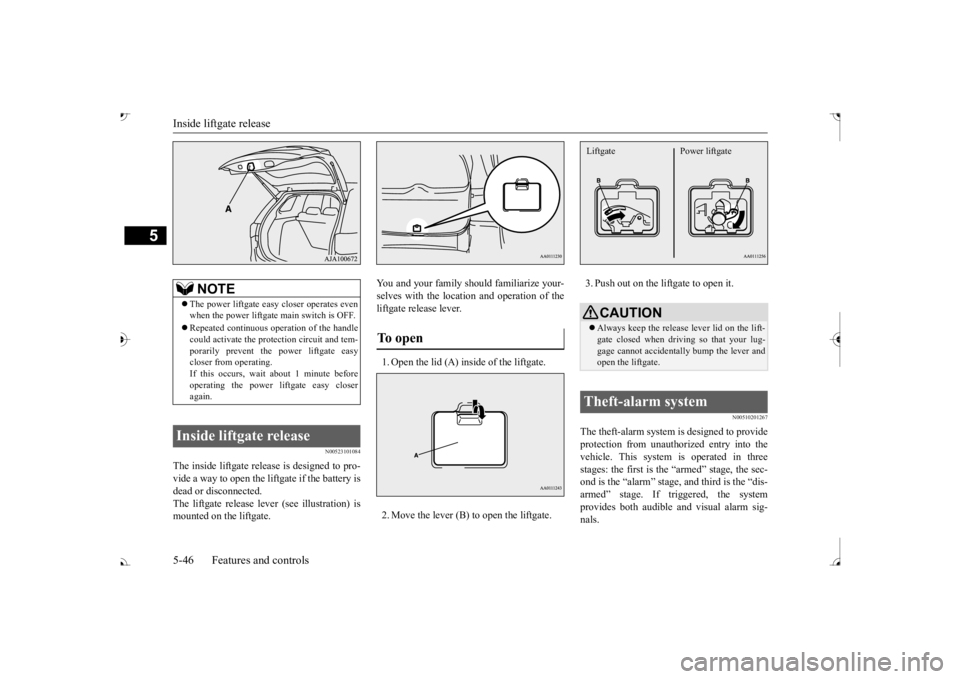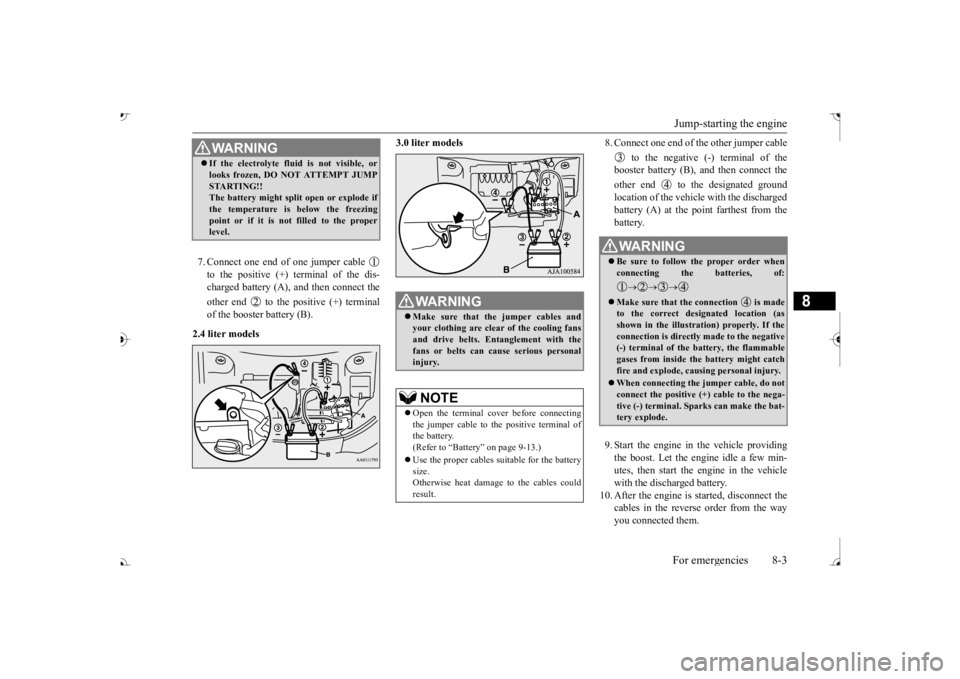Page 95 of 521

Free-hand Advanced
Security Transmitter (F.A.S
.T.-key) (if so equipped)
5
The operations possible with the F.A.S.T.- key can be modified as stated below.(Keyless entry operations are possible.) For details, contact an
authorized Mitsubi-
shi Motors dealer.• Enabling only the locking and unlocking of the doors and the liftgate • Enabling only the starting of the engine• Deactivating the F.A.S.T.-key
N00503201177
When a person enters the operating range ofthe F.A.S.T.-key while carrying the F.A.S.T.- key and presses the driver’s or front passen- ger’s door lock/unlock switch, the liftgateLOCK switch or the liftgate OPEN switch, verification of the ID
code is performed.
The doors and the liftgate can be locked andunlocked and the engine
can be started only
when the ID codes of the vehicle and F.A.S.T.-key match.
The operating range is
within about 2.3 feet
(70 cm) of the handles of the driver’s door, front passenger door and liftgate.
NOTE
The F.A.S.T.-key uses weak electromagnetic waves.In cases such as the following, operation may be improper or unstable. • The vehicle is near a facility that emits strong electromagnetic
waves, such as a TV
transmitting tower, a pow
er station, a radio
station or an airport • The key is carried together with other com- munication devices such
as cellular phones
or radios, or electrical appliances such as computers • The F.A.S.T.-key touches or is covered by a metal object • A keyless entry system is being used nearby • The battery of the F.A.S.T.-key is run down • The vehicle is in
a location with strong
electromagnetic
waves or noise
Use the emergency key in such circum- stances.Refer to “To operate without using theF.A.S.T.-key” on page 5-28. The F.A.S.T.-key is constantly performing reception operations
in its communication
with the vehicle. This means that the battery is always running down, regardless of howoften the F.A.S.T.-key is used. The battery life is about 1 to 3 years, depending on the usage conditions. Since the F.A.S.T.-key is constantly perform- ing reception operati
ons, the reception of
strong electromagnetic
waves can accelerate
the running down of the ba
ttery. Do not place
near to electrical appliances such as televi-sions or computers.
Operating range of the F. A . S . T. - k e y
NOTE
NOTE
When the battery of the F.A.S.T.-key has run down or there are st
rong electromagnetic
waves or noise in the area, the operating range could decrease
or operations could
become unstable.
Operating range for locking and unlocking the doors and the lift- gate
BK0239700US.book 14 ページ 2016年6月16日 木曜日 午前10時58分
Page 127 of 521

Inside liftgate release 5-46 Features and controls
5
N00523101084
The inside liftgate release is designed to pro- vide a way to open the liftgate if the battery is dead or disconnected. The liftgate release lever (see illustration) ismounted on the liftgate.
You and your family should familiarize your- selves with the location and operation of theliftgate release lever. 1. Open the lid (A) inside of the liftgate. 2. Move the lever (B) to open the liftgate.
3. Push out on the liftgate to open it.
N00510201267
The theft-alarm system is designed to provide protection from unauthorized entry into the vehicle. This system
is operated in three
stages: the first is the “armed” stage, the sec-ond is the “alarm” stage, and third is the “dis- armed” stage. If triggered, the system provides both audible and visual alarm sig-nals.
NOTE
The power liftgate easy closer operates even when the power liftgate main switch is OFF. Repeated continuous ope
ration of the handle
could activate the prot
ection circui
t and tem-
porarily prevent the
power liftgate easy
closer from operating. If this occurs, wait
about 1 minute before
operating the power liftgate easy closer again.
Inside liftgate release
To open
CAUTION Always keep the release lever lid on the lift- gate closed when driving so that your lug-gage cannot acci
dentally bump the lever and
open the liftgate.
Theft-alarm system Liftgate Power liftgate
BK0239700US.book 46 ページ 2016年6月16日 木曜日 午前10時58分
Page 438 of 521

Jump-starting the engine For emergencies 8-3
8
7. Connect one end of one jumper cable to the positive (+) terminal of the dis- charged battery (A),
and then connect the
other end to the positive (+) terminal of the booster battery (B).
2.4 liter models
3.0 liter models
8. Connect one end of the other jumper cable
to the negative (-) terminal of the booster battery (B), a
nd then connect the
other end to the designated ground location of the vehicl
e with the discharged
battery (A) at the point farthest from the battery. 9. Start the engine in the vehicle providing the boost. Let the engine idle a few min- utes, then start the engine in the vehiclewith the discharged battery.
10. After the engine is
started, disconnect the
cables in the reverse order from the wayyou connected them.
WA R N I N G If the electrolyte flui
d is not visible, or
looks frozen, DO NOT ATTEMPT JUMPSTARTING!!The battery might split open or explode if the temperature is below the freezing point or if it is not filled to the properlevel.
WA R N I N G Make sure that the jumper cables and your clothing are clear of the cooling fans and drive belts. Entanglement with thefans or belts can ca
use serious personal
injury.NOTE
Open the terminal cover before connecting the jumper cable to the positive terminal of the battery.(Refer to “Battery” on page 9-13.) Use the proper cables suitable for the battery size. Otherwise heat damage
to the cables could
result.
WA R N I N G Be sure to follow the proper order when connecting the batteries, of:
Make sure that the connection is made to the correct designated location (as shown in the illustration) properly. If theconnection is directly made to the negative (-) terminal of the battery, the flammable gases from inside the battery might catchfire and explode, caus
ing personal injury.
When connecting the jumper cable, do not connect the positive (+) cable to the nega- tive (-) terminal. Sparks can make the bat- tery explode.
BK0239700US.book 3 ページ 2016年6月16日 木曜日 午前10時58分